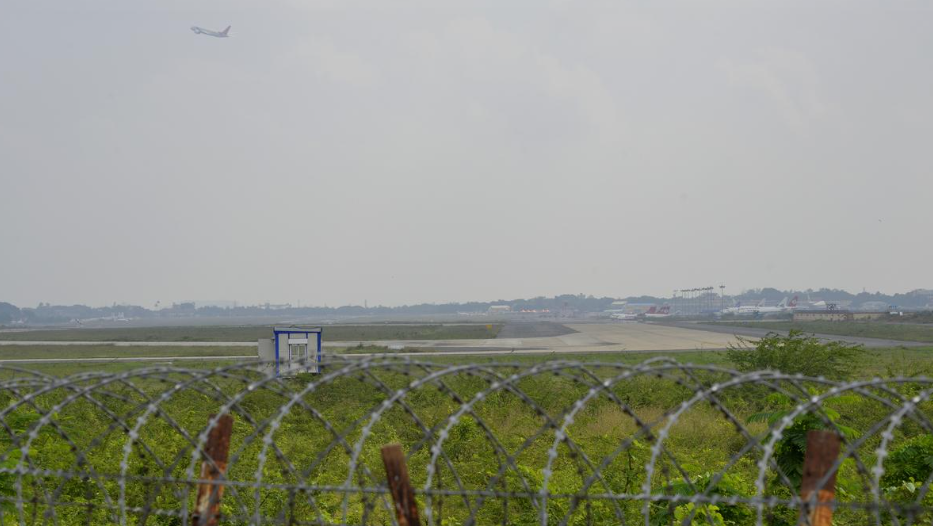Airports Where Pilots Could Fear to Land (GS Paper 3, Disaster Management)

Context and Introduction
- Recent incidents at major airports, particularly in Chennai and Doha, have raised serious safety concerns regarding runway integrity and infrastructure reliability.
- These issues underscore the vital importance of proper planning, design, and execution in airport construction and expansion.
- A recent incident involving a Qatar Airways Boeing 787, which nearly resulted in a serious accident at Doha's airport, highlights the potential dangers if these concerns are not adequately addressed.
- On October 25, 2024, after landing, the aircraft's right main landing gear sank into a ramp area that subsequently collapsed.
- Fortunately, the plane had slowed significantly, preventing a more catastrophic outcome.
- However, the incident serves as a critical reminder of the challenges faced by airports built on unstable foundations, particularly those situated on reclaimed land.
Structural Concerns at Doha Airport
Initial Recommendations
- The construction of Doha's new airport, which involves a substantial portion of reclaimed land, was originally advised by a Japanese contractor to require full concrete coverage.
- This recommendation was based on assessments that indicated the soil lacked the necessary strength to support heavy aircraft operations.
- Unfortunately, due to budget constraints, a less robust solution was selected, raising significant concerns about the long-term structural integrity of the airport.
Comparison with Other Airports
- Contrasting with Doha, other global airports built on reclaimed land, such as Singapore's Changi Airport and Hong Kong's Chek Lap Kok, have not encountered the same level of structural problems.
- These airports have successfully implemented rigorous engineering standards and construction practices that have allowed them to function efficiently and safely.
- This discrepancy raises questions about the planning processes and construction quality in Qatar.
Qatar's Response
- In light of these structural issues, Qatar has expressed a commitment to rectifying any deficiencies found in the airport's operational areas.
- This response is crucial for maintaining safety standards and ensuring that the airport can handle the growing demands of international aviation.
Chennai Airport's Expansion Challenges
Historical Background
- Chennai's airport expansion plans have been mired in challenges since they were proposed in 2007.
- The initial project aimed to construct a parallel runway and extend the secondary runway over the Adyar River.
- However, initial soil testing revealed that the conditions were unsuitable for such ambitious infrastructure, leading to a significant redesign of the project.
Shifts in Contractors
- After the withdrawal of the experienced contractor Larsen & Toubro due to the unsuitable soil conditions, the Airports Authority of India (AAI) awarded the project to Consolidated Construction Consortium Limited (CCCL).
- This firm, lacking substantial experience in large-scale infrastructure projects, raised concerns about the quality and safety of the construction processes being employed.
Safety Violations and Structural Shortcomings
- Numerous safety violations have emerged in the construction of the airport's infrastructure.
- For example, discrepancies regarding the bridge over the Adyar River have been alarming.
- The bridge's supporting pillars were built with a diameter significantly smaller than specified, and the structure itself was erected below the mandated flood level.
- These failures were notably evident during the floods in 2015, which resulted in severe damage and destruction in the vicinity of the airport.
Recent Flood Events and Future Concerns
- Chennai has faced increasingly severe flooding in recent years, raising alarms about the infrastructure's ability to withstand extreme weather.
- Experts suggest that climate change is likely to increase the frequency and severity of such events, making it essential for airports to adhere to stringent safety and design standards.
The Greenfield Airport Project
- Plans for a new greenfield airport in Parandur are underway, aimed at constructing an airport on land that is rich in water bodies.
- However, this ambitious project poses substantial risks to the local environment and flood management.
- Without comprehensive soil testing and a detailed assessment of how such construction would affect existing water flows, the potential for exacerbating flooding risks is high.
Economic Viability and Public Impact
- The economic implications of these airport projects are significant.
- Given the history of budget overruns and project mismanagement, there is a strong need for careful cost-benefit analyses to ensure that public funds are not wasted.
- The lessons learned from the stalled parallel runway project must inform future decisions to prevent similar missteps.
Aircraft Impact and Structural Demands
- Designing runways capable of accommodating large aircraft necessitates advanced engineering to endure immense forces during landings.
- For instance, when a large aircraft lands, it can exert forces far beyond its weight, especially during adverse weather conditions like strong crosswinds.
- This necessitates a high level of expertise in soil mechanics and structural engineering to ensure safety and operational efficacy.
Conclusion
- The challenges facing Chennai and Doha airports serve as stark reminders of the importance of sound infrastructure planning and execution.
- As Bengaluru emerges as a dominant aviation hub, Chennai risks losing its historical significance due to inadequate planning and poor infrastructure.
- For the safety of passengers and the viability of the aviation sector, both Chennai and Doha must take proactive measures to address these structural concerns.
- Ensuring that airports are built to the highest standards is critical not only for operational success but also for safeguarding the lives of those who depend on air travel.
- Rigorous oversight, proper funding, and adherence to engineering best practices will be essential in creating a secure and reliable aviation infrastructure for the future.


